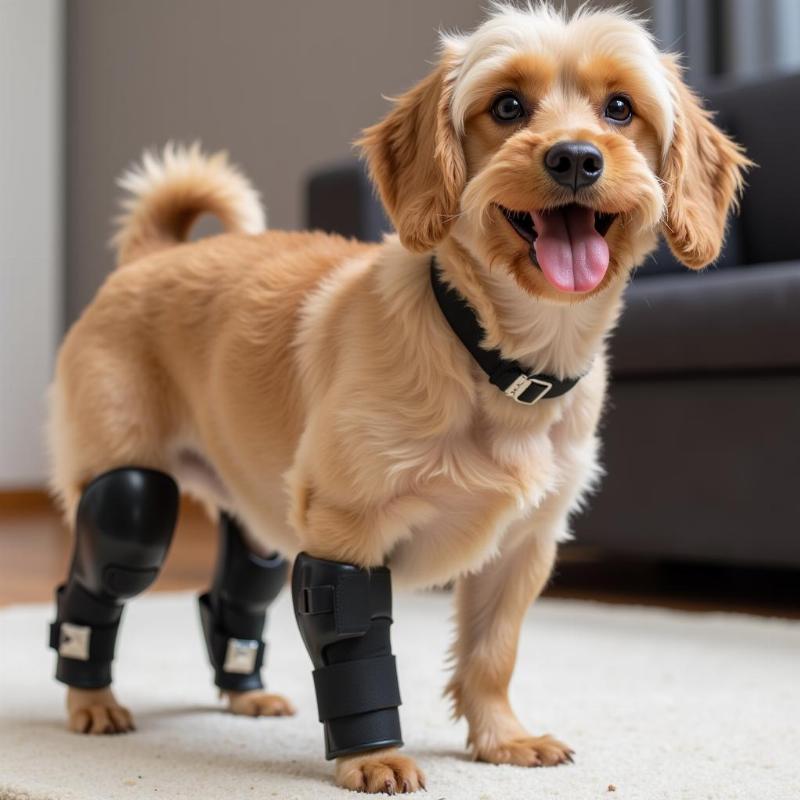If your dog is suddenly limping or favoring a leg, you’re likely worried and wondering, “What does lame mean in dogs?” Lameness in dogs simply means they are experiencing difficulty or pain when walking or running. It can range from a slight limp to a complete inability to bear weight on a limb. Understanding the causes, symptoms, and treatment options for lameness is crucial for every dog owner in the US.
Recognizing Lameness in Your Dog
Lameness isn’t always obvious. Sometimes, it’s a subtle shift in your dog’s gait. Other times, it’s a dramatic yelp followed by a refusal to move. Here’s what to look for:
- Limping: This is the most common sign. The dog may lift the affected leg, take shorter strides, or avoid putting weight on it altogether.
- Stiffness: Your dog might appear stiff, especially after rest or exercise.
- Swelling: Check for any swelling or redness around the joints or limbs.
- Pain: Your dog might whimper, yelp, or show signs of discomfort when the affected area is touched.
- Changes in behavior: A normally active dog might become withdrawn, reluctant to play, or show decreased appetite.
- Licking or chewing: Excessive licking or chewing at a specific area can indicate pain or discomfort.
Common Causes of Lameness in Dogs
Lameness in dogs can stem from various issues, affecting bones, joints, muscles, tendons, ligaments, or even nerves. Some common culprits include:
- Injuries: Sprains, strains, fractures, and dislocations are common, especially in active dogs. Even seemingly minor injuries like a torn nail can cause significant lameness.
- Arthritis: This degenerative joint disease is more prevalent in older dogs and can cause pain, stiffness, and reduced mobility.
- Hip and Elbow Dysplasia: These genetic conditions affect the hip and elbow joints, respectively, leading to lameness and arthritis.
- Cruciate Ligament Injuries: Similar to ACL tears in humans, these are common knee injuries in dogs, often requiring surgical intervention.
- Infections: Infections in the bones, joints, or soft tissues can cause pain and lameness.
What to Do if Your Dog is Lame
If you notice your dog is lame, it’s important to seek veterinary care. Don’t try to diagnose or treat the problem yourself.
- Restrict activity: Keep your dog quiet and rested to prevent further injury.
- Observe closely: Note the severity of the lameness, which leg is affected, and any other accompanying symptoms.
- Contact your veterinarian: Schedule an appointment as soon as possible. Your veterinarian will conduct a thorough examination to determine the cause of the lameness.
Treatment Options for Canine Lameness
Treatment for lameness varies depending on the underlying cause. Options may include:
- Pain medication: Nonsteroidal anti-inflammatory drugs (NSAIDs) can help reduce pain and inflammation. Never give your dog human medications without consulting your veterinarian.
- Rest and restricted activity: This is crucial for allowing the injured area to heal.
- Physical therapy: Exercises and stretches can help improve mobility and strength.
- Surgery: In some cases, surgery may be necessary to repair fractures, torn ligaments, or address other structural issues.
- Supplements: Supplements like glucosamine and chondroitin can help support joint health.
 Dog Wearing Brace
Dog Wearing Brace
When is Lameness an Emergency?
While not all cases of lameness are emergencies, some situations require immediate veterinary attention:
- Sudden onset of severe lameness: This could indicate a fracture or other serious injury.
- Inability to bear weight: If your dog cannot put any weight on a limb, it’s crucial to seek immediate care.
- Swelling, redness, or heat around a joint or limb: These signs could indicate an infection.
- Obvious deformity: A broken bone or dislocated joint requires immediate veterinary attention.
Conclusion
Understanding what lame means in dogs and recognizing the signs can help you provide the best possible care for your furry friend. Early diagnosis and treatment are crucial for managing lameness and ensuring your dog’s comfort and well-being. Don’t hesitate to contact your veterinarian if you have any concerns about your dog’s mobility.
FAQ
- How can I tell if my dog is in pain? Look for signs like limping, whining, changes in behavior, reluctance to move, and excessive licking or chewing at a specific area.
- Should I give my dog human pain relievers? No, never give your dog human medications without consulting your veterinarian. Many human medications are toxic to dogs.
- How long does it take for a dog to recover from lameness? Recovery time depends on the underlying cause and can range from a few weeks to several months.
- Can lameness be prevented? While not all causes of lameness are preventable, maintaining a healthy weight, providing regular exercise, and avoiding high-impact activities can help reduce the risk.
- What is the difference between a sprain and a strain? A sprain involves injury to ligaments, while a strain involves injury to muscles or tendons.
- Is lameness more common in certain breeds? Some breeds are predisposed to certain orthopedic conditions that can cause lameness, such as hip dysplasia in large breeds.
- What are some alternative therapies for canine lameness? Acupuncture, laser therapy, and hydrotherapy can be beneficial in some cases.
Related Articles
- high levels of alkaline phosphatase in dogs
- medial shoulder instability in dogs
- what does ringworm look like in a dog
- grade 1 soft tissue sarcoma in dogs
Beautdogs.us is your premier online destination for comprehensive and reliable information on dog care, breeds, and lifestyle. We offer expert advice and resources for dog owners of all levels, from novice pet parents to seasoned canine enthusiasts. Whether you’re looking for guidance on dog health, training, nutrition, or grooming, Beautdogs.us is here to help. Contact us today at [email protected] or +1 501-555-7529.